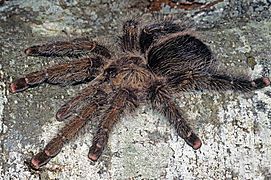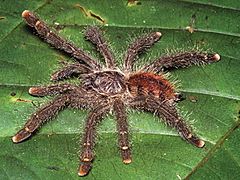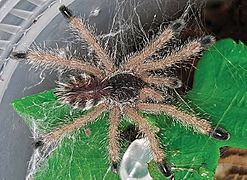Avicularia juruensis facts for kids
Quick facts for kids Avicularia juruensis |
|
|---|---|
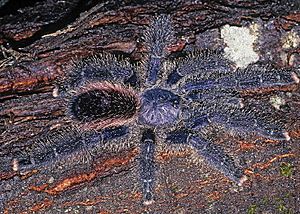 |
|
| Female, morphotype 2 | |
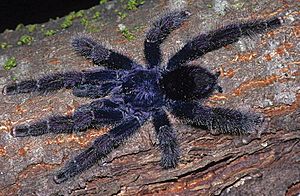 |
|
| Male, morphotype 2 | |
| Scientific classification | |
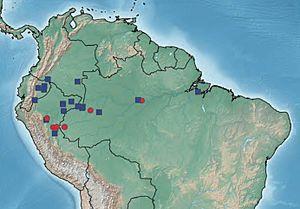 |
|
| Red circles = morphotype 1, blue squares = morphotype 2 | |
| Synonyms | |
|
The Avicularia juruensis is a type of spider that belongs to the tarantula family, called Theraphosidae. You can find this spider in parts of South America, including Colombia, Ecuador, Peru, and Brazil.
This spider is also known by the English name Amazonian pink toe spider. Sometimes, it's called the Peruvian pinktoe tarantula, especially when people used its old scientific name, Avicularia urticans. Scientists decided in 2017 that Avicularia urticans was actually the same spider as Avicularia juruensis.
It's a fairly large spider. Its body can be over 30 mm (about 1.2 inches) long. When its legs are fully stretched out, they can reach about 60 mm (about 2.4 inches). Like other spiders in the Avicularia group, these spiders are sometimes sold as pets.
Contents
About the Amazonian Pink Toe Spider
This section tells you more about what the Avicularia juruensis spider looks like.
Size and Body Parts
An adult female Avicularia juruensis has a body that is bigger than the male's. Her main body section, called the carapace, is about 19 mm long and 17 mm wide. Her abdomen, which is the back part of her body, is about 24 mm long and 17 mm wide.
The adult male is smaller. His carapace is about 15 mm long and wide. His abdomen is also smaller, about 17 mm long and 12 mm wide.
The spider's fourth leg is a bit longer than its first leg. Both of these are longer than the two middle legs. For example, a female's first leg can be 53 mm long, and her fourth leg can be 58 mm long. A male's first leg can be 56 mm long, and his fourth leg can be 60 mm long.
The spider has eight eyes, arranged in two rows of four. The front row curves slightly forward, and the back row curves slightly backward. The abdomen of these spiders has special hairs called urticating hairs. These hairs can be up to 1 mm long in males and 0.7 mm long in females. They can cause irritation if they get on skin.
Colour Changes and Forms
Young Avicularia juruensis spiders look very different from adults. Young spiders do not have a shiny, metallic look. Their feet (tarsi) are black, which stands out against the lighter colour of the rest of their legs. They also have a reddish top part of their abdomen with a black stripe down the middle and other black stripes across it.
As they grow into adults, they lose the stripes on their abdomen. Instead, they get a shiny, metallic look.
There are two main colour forms, or "morphotypes," of this spider:
- Morphotype 1 has a golden and pink shine. Its carapace (the top shell) is whitish, and its leg rings are also whitish. It has longer light brown hairs mixed with shorter, darker hairs. Males of this form usually do not have white tips on the hairs of their upper abdomen. This is the form that was previously known as A. urticans.
- Morphotype 2 has a strong purple shine. Its leg rings are more yellow. Females of this form have long reddish-brown hairs on the front and sides of their upper abdomen, over shorter, darker hairs. Males have white-tipped hairs spread evenly over their upper abdomen.
Morphotype 1 is more common in Brazil, while Morphotype 2 is found more often in Ecuador and Peru. However, you can find both types in different areas.
- Variation in colour patterns
Spider Names and History
Avicularia juruensis was first described by a scientist named Cândido Firmino de Mello-Leitão in 1923. He found the spiders in a place called Juruá in Brazil, which is why the spider's name includes "juruensis."
Later, in 1994, another scientist named Gunter Schmidt described a spider he called Avicularia urticans. He found these spiders in Peru.
However, in 2017, two scientists, Caroline Fukushima and Rogério Bertani, studied both spiders carefully. They decided that A. urticans was actually the same species as A. juruensis. This is called synonymy, meaning two different names were given to the same animal. Even though there were some small colour differences, they were considered the same species.
Sometimes, the name A. juruensis has been incorrectly used for another spider, Avicularia rufa. This happened with spiders found in the Brazilian states of Mato Grosso and Rondônia, which are south of where A. juruensis usually lives.
Spider Behaviour
Scientists don't know a lot about the daily lives and habits of most Avicularia species. There haven't been many detailed studies.
However, one interesting observation was made: an adult female Avicularia juruensis was seen on the side of a palm tree. She was eating a greater sac-winged bat (Saccopteryx bilineata). This shows that these spiders can hunt and eat surprisingly large prey! In Peru, these spiders have also been known to swim across big rivers.
Where They Live
The Avicularia juruensis spider lives in central South America. You can find it in Colombia, Ecuador, Peru, and in the Brazilian states of Amazonas, Acre, and Pará.
Like other spiders in the Avicularia group, these spiders live in trees. They build their homes, which are like silken nests, high up in the branches.
See also
 In Spanish: Avicularia urticans para niños
In Spanish: Avicularia urticans para niños


